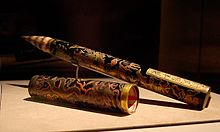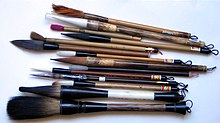Ink brush

Ink brushes (simplified Chinese: 毛笔; traditional Chinese: 毛筆; pinyin: máo bǐ; Japanese: 筆, romanized: fude; Korean: 붓/筆) are used in Chinese calligraphy as well as Japanese calligraphy and Korean calligraphy which have a root of Chinese calligraphy. They are also used in Chinese painting and other brush painting styles. The brush was invented in China around 300 B.C.[1][2] Together with the inkstone, inkstick and Xuan paper, these four writing implements form the Four Treasures of the Study.
Types

Brushes differ greatly in terms of size, texture, material, and cost. The brush hair chosen depends on one's needs at the moment; certain kinds of brushes are more suited to certain script styles and individuals than others.
- Handle: usually of bamboo, exotic brushes may instead use such materials as gold, silver, jade, ivory, red sandalwood or spotted bamboo.
- Hair source: normally the brush is made from goat, Siberian weasel (ch: 黄鼠狼 huángshǔláng, yellow-rat-wolf), pig, mouse, buffalo, wolf, or rabbit hair, while exotic ones can be made from tiger, fowl, deer, and even human hair (from a baby's first haircut, said to bring good fortune while taking the imperial examinations).
- Hair texture: soft (ch: 軟毫 ruǎnháo), mixed (ch: 兼毫 jiānháo), or hard (ch: 硬毫 yìngháo) hair.
- Hair size: generally classified as either big (ch: 大楷 dàkǎi, ja: 大筆 oofude), medium (ch: 中楷 zhōngkǎi, ja: 中筆 chufude), or small (ch: 小楷 xiǎokǎi, ja: 小筆 kofude)[3]; most calligraphy is written with a medium-sized brush. The smallest brushes are used for very small pieces and for fashioning designs for seals. While medium size brushes are the most widely used, wielded by a skilled artist a medium brush can produce a variety of thicknesses of line from very thin to fairly thick. The largest brushes are used only for very large pieces.
- Hair length: generally classified by hair length for thickness of handle as either long (ja: 長鋒 chouhou), medium (ja: 中鋒 chuhou), short (ja: 短鋒 tannhou); most calligraphy is written with a medium-length hair brush. The long hair brush are more keep to hold a ink than the short hair brushes as their length. So, it used for continuous long stroke line scripting such as Japanese traditional hiragana style by rennmen( ja: 連綿 ). The hair of long hair brushes are tend to made by hard texture hair to keep their hair form, but there is a not one. Japanese very long and slender hair brushes called menso-burushes( ja: 面相筆 ) are used for detail painting.[4]
Synthetic hair is not traditionally used. Prices vary greatly depending on the quality of the brush; cheap brushes cost less than one US dollar while expensive brushes can cost more than a thousand dollars. Currently, the finest brushes are made in the town of Shanlian, in the Nanxun District, prefecture-level city of Huzhou, of Zhejiang province.
History

This section needs expansion. You can help by adding to it. (June 2008) |
The earliest intact ink brush was found in 1954 in the tomb of a Chu citizen from the Warring States period (475-221 BCE) located in an archaeological dig site Zuo Gong Shan 15 near Changsha (長沙). The primitive version of an ink brush found had a wooden stalk and a bamboo tube securing the bundle of hair to the stalk. Legend wrongly credits the invention of the ink brush to the later Qin general Meng Tian.[citation needed]
Traces of the writing brush, however, were discovered on the Shang jades, and were suggested to be the grounds of the oracle bone inscriptions.[5]
Fudepen
The Fudepen, also known as a "Brush Pen", is a modern Japanese invention analogous to a Fountain pen. Today, Japanese companies such as Pentel and Sakura Color Products Corporation manufacture pens with tips resembling those of a small ink brush. These brush pens work almost identically to small ink brushes and can be used for most of the same purposes.
See also
References
- ^ Ong, Siew Chey (2005). China condensed: 5000 years of history & culture. Singapore: Marshall Cavendish. p. 161. ISBN 978-981-261-067-6.
- ^ Women of China, Issues 1-6. Foreign Language Press. 1995. p. 1.
- ^ 榊, 莫山 (1981-05-30). 文房四宝 筆の話 (1 ed.). 角川書店. p. 202.
- ^ 堀, 久夫 (2001-03-16). 書筆使いこなしハンドブック (1 ed.). 可成屋. p. 128. ISBN 4-8393-8721-4.
- ^ Cambridge History of Ancient China, 1999:108
